Sweet Corn IPM Newsletter No. 5- July 30, 2021
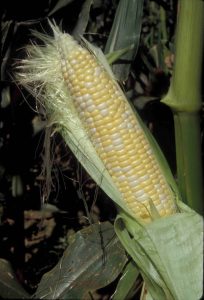
Sweet Corn IPM Newsletter No. 5- July 30, 2021
FALL ARMYWORM & CORN BORER THREATEN SILKING CORN
Corn Earworm Numbers Low, But Western Bean Cutworm Numbers Higher
SITUATION
With corn harvest getting into full swing in Southern Maine, many fields received another soaking this week. Nitrogen deficiency, indicated by yellowing of the lower leaves, is becoming evident in some fields as excessive rains have leached much of the nitrogen out of the soil. For corn, not yet in tassel, supplementary applications of nitrogen may be beneficial.
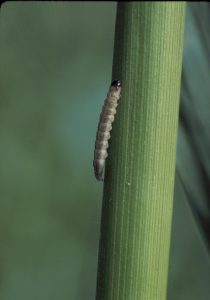
European corn borer:
Larval feeding injury was not over the 15% control threshold in any locations this week although low levels of feeding activity was observed in most fields. European corn borer moth trap counts were over the spray threshold of 5/week at Monmouth, Sabattus and one Dayton site.
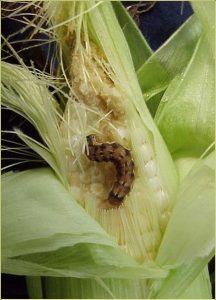
Corn earworm:
Where are the corn earworms? It appears conditions for migration, mating and egg laying have been poor for this insect so far this summer and this trend has been seen throughout the region. Moth captures in pheromone traps were very low this week; only two sites: Auburn and one Dayton field, have a recommended 6-day spray interval to protect against corn earworm in silking fields. No other sites required control of corn earworm. This is an unusual break from earworm pressure at this point in the season, but the situation could change soon, and growers should be prepared for increased activity.
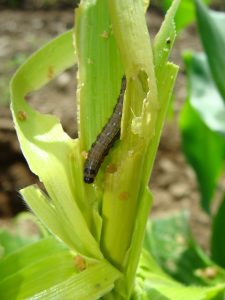
Fall armyworm:
We continue to catch fall armyworm moths in most locations, but most were not above the threshold of 3 moths per week in silking corn. Sprays to protect silking corn were recommended in Garland, Lewiston, Monmouth and New Gloucester, where these fields were not on a spray schedule for corn earworm. The Auburn site was over the threshold for fall armyworm, but is protected with the spray schedule recommended for corn earworm. We have not yet found any feeding damage in the field, but expect it will become visible soon.

Western Bean Cutworm:
Moth counts continue to rise in our pheromone traps, ranging from 2 to 89 at sites around the state. The threat this “new” pest poses is thought to be similar to fall armyworm, therefore we are recommending protection when feeding levels reach 8% in a field, or when moths are active in silking fields, which is the case at most locations this week.
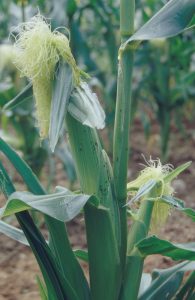
Corn leaf aphids may infest corn plants in fields that have not recently been sprayed for other pests. Colonies of these small, bluish-green insects can nearly cover the tassels, stalks and husks. The waste aphids excrete on the plants, called “honeydew”, stimulates the development of sooty mold fungus. This dark, slimy fungus coats the surface of the husks, reducing the appearance of the ears. Sprays applied for corn earworm usually control aphids. Sprays for aphids would only be recommended if sooty mold is becoming a problem.

Squash vine borer:
Moths captures in pheromone traps were over the threshold of 5 this week in Monmouth and Biddeford. Activity of the pest seems to be increasing, so growers should be on the lookout for feeding at the base of the plants and/or wilting vines, and apply appropriate control if damage is found.
Sincerely,
David T. Handley
Vegetable & Small Fruit Specialist
Highmoor Farm Pest Management Unit
P.O. Box 179 17 Godfrey Drive
52 U.S. Route 202 Orono, ME 04473
Monmouth, ME 04259
207.933.2100 1.800.287.0279
| Location | CEW
Moths |
ECB
Moths |
FAW
Moths |
%Feeding
Damage |
Recommendations / Comments |
|---|---|---|---|---|---|
| Auburn | 2 | 1 | 13 | 0% | 6-day spray interval for silking corn |
| Biddeford | 1 | 1 | 2 | 9% | No spray recommended |
| Bowdoinham | 1 | 1 | 0 | 1% | No spray recommended |
| Cape Elizabeth | 1 | 0 | 0 | 3% | No spray recommended |
| Dayton I | 0 | 6 | 0 | 1% | One spray for ECB on silking corn |
| Dayton II | 2 | 3 | 1 | 1% | 6-day spray interval for silking corn |
| Farmington | 0 | 1 | 0 | 0% | No spray recommended |
| Garland | 1 | 0 | 5 | One spray for FAW on silking corn | |
| Lewiston | 1 | 0 | 12 | 3% | One spray for FAW on silking corn |
| Monmouth | 1 | 6 | 13 | 11% | One spray for ECB+FAW on silking corn |
| New Gloucester | 0 | 0 | 15 | 3% | One spray for FAW on silking corn |
| Oxford | 0 | 2 | 2 | 1% | No spray recommended |
| Palmyra | 0 | 0 | 2 | 0% | No spray recommended |
| Sabattus | 0 | 11 | 0 | 3% | One spray for ECB on silking corn |
| Wayne | 0 | 0 | 0 | 4% | No spray recommended |
| Wells | 1 | 2 | 1 | 1% | No spray recommended |
CEW: Corn earworm (Only fresh silking corn should be sprayed for this insect.)
ECB: European corn borer
FAW: Fall armyworm
| Moths caught per week | Moths caught per night | Spray interval |
|---|---|---|
| 0.0 to 1.4 | 0.0 to 0.2 | No spray |
| 1.5 to 3.5 | 0.3 to 0.5 | Spray every 6 days |
| 3.6 to 7.0 | 0.6 to 1.0 | Spray every 5 days |
| 7.1 to 91 | 1.1 to 13.0 | Spray every 4 days |
| More than 91 | More than 13 | Spray every 3 days |
Thresholds apply only to corn with exposed fresh silk. Lengthen spray intervals by one day if maximum daily temperature is less than 80°F. European Corn Borer Thresholds
Whorl stage: 30% or more of plants scouted show injury.
Pre-tassel-silk: 15% or more of plants scouted show injury.
Silk: 5 or more moths caught in pheromone traps in one week.
IPM Web Pages:
Where brand names or company names are used, it is for the reader’s information. No endorsement is implied nor is any discrimination intended against other products with similar ingredients. Always consult product labels for rates, application instructions and safety precautions. Users of these products assume all associated risks.
The University of Maine is an equal opportunity/affirmative action institution.
